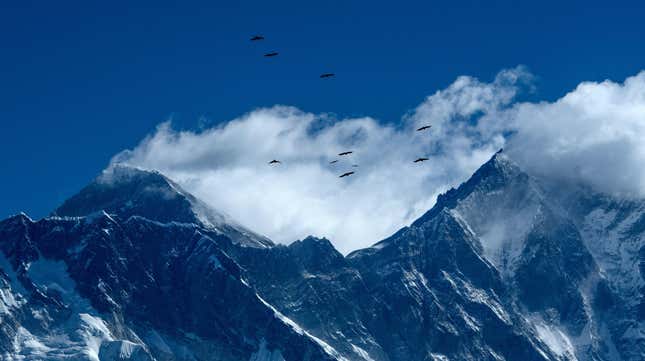
Climbing Mount Everest is one of the hardest athletic feats a person can do. But new research out this week suggests that it has gotten easier to pull off in recent years. The study found the success rate of climbing the highest mountain on Earth has doubled in the last decade relative to years past, while the likelihood of dying has stayed about the same, even as more people have attempted the journey.
Lead author Raymond Huey, an evolutionary biologist and professor emeritus at the University of Washington, is no alpinist himself. But after hearing a lecture from Reinhold Messner, a renowned climber who in 1978 became one of the first to climb Mount Everest without supplemental oxygen, Huey felt compelled to see if his own expertise could be applied to the history of mountaineering on Everest.
“I wondered whether it was possible to apply analytical techniques we use in evolutionary biology and epidemiology to evaluate what was safe or risky on Himalayan peaks,” Huey said.
For their study, Huey worked with statisticians Cody Carroll and Jane-Ling Wang as well as Richard Sainsbury, a Himalayan climber and retired computer analyst. Sainsbury is one of the co-founders of The Himalayan Database, an archival record of attempts to climb Mount Everest and the hundreds of other Himalayan mountains in or bordering the country of Nepal. Much of this history, dating from 1905 through Spring 2020, was collected by Elizabeth Hawley, a journalist who died in 2018 at age 94. Though Hawley’s records were occasionally disputed, the mountaineering community at large had great admiration for her, and Nepal even named a mountain peak after her in 2014.
With these records, Huey and his team analyzed the success and death rate of first-time attempts up Everest during the years 2006 to 2019, then compared it to a previous analysis covering the years 1990 to 2005.
Over 2,200 people attempted for the first time to reach the summit during the earlier time period, while more than 3,600 people did the same between 2006 and 2019. Between those two time periods, there was a clear improvement in how likely people were to make it to the summit (the point of a mountain where there is nothing immediately higher than it in elevation).
“The probability of reaching the summit and surviving has shot up in recent decades: about 2/3 of climbers during 2006 to 2019 reached the summit and survived. But the probability of dying has remained essentially constant, about 1%,” said Huey. From 1990 to 2005, the rate of success was around one-third.
The findings were published in PLOS-ONE.
While most of the climber were men, the percentage of women climbers has increased over time, with about 15% of climbers being women during 2006 to 2019; women and men had similar success rates. The percentage of older climbers also increased, with more than half being over 40 during recent years. That said, older climbers did have a slightly higher risk of dying than younger ones.
Though climbing Everest remains a niche and dangerous hobby, the study’s findings might provide some clarity on how to make the journey safer once climbing is allowed again (covid-19 led to the cancellation of the 2020 season).
For one, the study found no evidence that the crowding of climbers going up the mountain in a long line seen in recent years was associated with any heightened risk of death or lower chance of success, as some experts have worried. But Huey notes that an untimely avalanche or snowstorm could still prove especially dangerous for climbers, and crowding does slow down climbing. As with other research, they also found no link between relative inexperience on other Nepalese mountains and the success or death rates, possibly because climbers nowadays are taking advantage of commercial expeditions more, which are usually managed by experienced mountaineers. Other factors for success likely include better weather forecasting and the greater use of fixed ropes along the mountain that allow people to stay attached and lessen their risk of falling.
For those willing to make the arduous journey, though, Huey still recommends that people cut their teeth on something a little easier to start with.
“If the goal is to increase one’s chances of reaching the summit and also getting home alive, then first testing oneself on a lower but still high peak will inform individuals how they respond physically and mentally to high elevation,” he said. “Also, being relatively young, perhaps 20 to 45, helps, although one 80-year-old climber did summit and survive. Finally, they must also be willing to climb in a long line.”